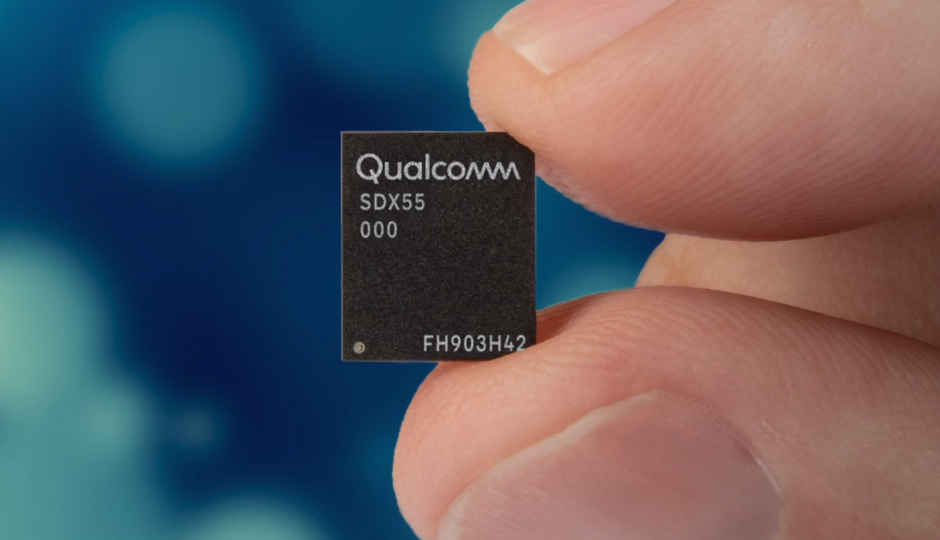 Highlights: Qualcomm announced the Snapdragon X55, the company's second-gen 5G modem. The modem will be introduced in a Samsung device, Qualcomm said first devices to be expected in 2020. The Snapdragon X55 supports both 4G and 5G connetivity. Even when the Qualcomm Snapdragon X50 5G modem is seeing the light of the day for the first time among the first-generation 5G devices like the Xiaomi Mi Mix 3 5G, Huawei Mate X, Samsung Galaxy S10 5G and the likes, Qualcomm is already thinking ahead. The chipset designer announced the Snapdragon X55 5G modem, the second-generation 5G modem that will succeed the Snapdragon X50. At the same event, Samsung announced it will be the first to implement the Snapdragon X55 modem. Qualcomm said the sampling of the modem will begin from Q2 2019 and the first devices touting the second-gen 5G modem will begin rolling out in 2020. The Snapdragon X50 modem offers both 4G and 5G in a single chip. The chip offers peak downlink of 7Gbps and also supports 5G standalone, the next-gen 5G infrastructure that will roll out in the second wave. The 5G chip supports both mmWave and sub-6GHz spectrum of 5G connectivity, same as the X50. But it’s theoretical speeds are bumped up from 5Gbps to 7Gbps with up to 3Gbps upload. More crucially, the Snapdragon X55 supports 5G FDD which is required in Europe and other places to make use of low-frequency spectrum for 5G connectivity. The Snapdragon X55 also offers 4G/5G spectrum sharing. The chip supports Category 22 LTE standard and offers a peak downlink of 2.5Gbps using Full Dimensional MIMO (FD-MIMO) for LTE that has 3D beamforming which makes better use of the available spectrum. It’s Qualcomm’s fastest 4G solution yet. Furthermore, the chip has better antenna tuning that improves power management. More importantly, the chip supports 5G Standalone specification. For now, all 5G infrastructure is based on 5G Non-Standalone (NSA) specification which will eventually transition to 5G Standalone. When that happens, devices sporting the modem will continue to connect to 5G networks. 5G Standalone essentially ditches the LTE backend, moving entirely to 5G infrastructure, allowing for more network flexibility and Network Slicing that offers lower latency to IoT devices. Qualcomm paid for Digit correspondent's travel and stay at MWC, Barcelona Related Reads: MWC 2019: Qualcomm announces 5G chip for PCs, Wi-Fi chip for automobiles Samsung Galaxy Fold unfolded in a 4-minute long video
Highlights: Qualcomm announced the Snapdragon X55, the company's second-gen 5G modem. The modem will be introduced in a Samsung device, Qualcomm said first devices to be expected in 2020. The Snapdragon X55 supports both 4G and 5G connetivity. Even when the Qualcomm Snapdragon X50 5G modem is seeing the light of the day for the first time among the first-generation 5G devices like the Xiaomi Mi Mix 3 5G, Huawei Mate X, Samsung Galaxy S10 5G and the likes, Qualcomm is already thinking ahead. The chipset designer announced the Snapdragon X55 5G modem, the second-generation 5G modem that will succeed the Snapdragon X50. At the same event, Samsung announced it will be the first to implement the Snapdragon X55 modem. Qualcomm said the sampling of the modem will begin from Q2 2019 and the first devices touting the second-gen 5G modem will begin rolling out in 2020. The Snapdragon X50 modem offers both 4G and 5G in a single chip. The chip offers peak downlink of 7Gbps and also supports 5G standalone, the next-gen 5G infrastructure that will roll out in the second wave. The 5G chip supports both mmWave and sub-6GHz spectrum of 5G connectivity, same as the X50. But it’s theoretical speeds are bumped up from 5Gbps to 7Gbps with up to 3Gbps upload. More crucially, the Snapdragon X55 supports 5G FDD which is required in Europe and other places to make use of low-frequency spectrum for 5G connectivity. The Snapdragon X55 also offers 4G/5G spectrum sharing. The chip supports Category 22 LTE standard and offers a peak downlink of 2.5Gbps using Full Dimensional MIMO (FD-MIMO) for LTE that has 3D beamforming which makes better use of the available spectrum. It’s Qualcomm’s fastest 4G solution yet. Furthermore, the chip has better antenna tuning that improves power management. More importantly, the chip supports 5G Standalone specification. For now, all 5G infrastructure is based on 5G Non-Standalone (NSA) specification which will eventually transition to 5G Standalone. When that happens, devices sporting the modem will continue to connect to 5G networks. 5G Standalone essentially ditches the LTE backend, moving entirely to 5G infrastructure, allowing for more network flexibility and Network Slicing that offers lower latency to IoT devices. Qualcomm paid for Digit correspondent's travel and stay at MWC, Barcelona Related Reads: MWC 2019: Qualcomm announces 5G chip for PCs, Wi-Fi chip for automobiles Samsung Galaxy Fold unfolded in a 4-minute long videofrom Latest Technology News https://ift.tt/2IxkFuO









